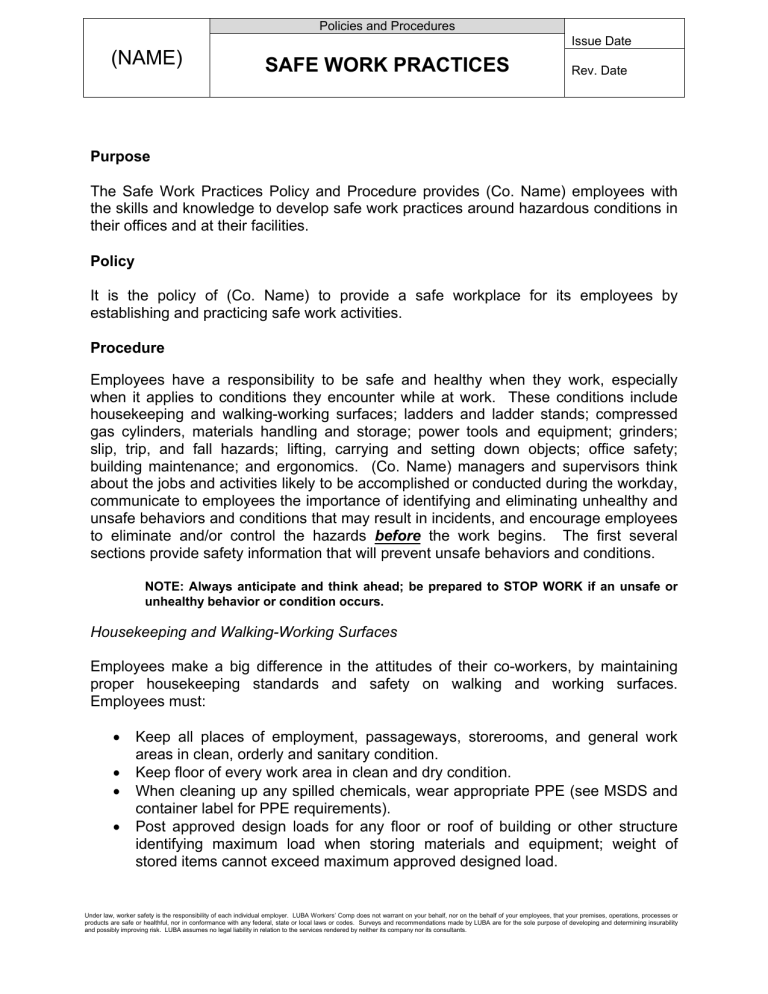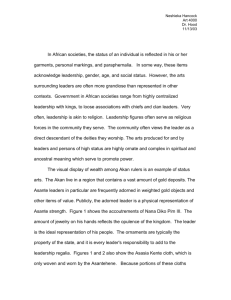Safe Work Practices - LUBA Workers` Comp.

(NAME)
Policies and Procedures
SAFE WORK PRACTICES
Issue Date
Rev. Date
Purpose
The Safe Work Practices Policy and Procedure provides (Co. Name) employees with the skills and knowledge to develop safe work practices around hazardous conditions in their offices and at their facilities.
Policy
It is the policy of (Co. Name) to provide a safe workplace for its employees by establishing and practicing safe work activities.
Procedure
Employees have a responsibility to be safe and healthy when they work, especially when it applies to conditions they encounter while at work. These conditions include housekeeping and walking-working surfaces; ladders and ladder stands; compressed gas cylinders, materials handling and storage; power tools and equipment; grinders; slip, trip, and fall hazards; lifting, carrying and setting down objects; office safety; building maintenance; and ergonomics. (Co. Name) managers and supervisors think about the jobs and activities likely to be accomplished or conducted during the workday, communicate to employees the importance of identifying and eliminating unhealthy and unsafe behaviors and conditions that may result in incidents, and encourage employees to eliminate and/or control the hazards before the work begins. The first several sections provide safety information that will prevent unsafe behaviors and conditions.
NOTE: Always anticipate and think ahead; be prepared to STOP WORK if an unsafe or unhealthy behavior or condition occurs.
Housekeeping and Walking-Working Surfaces
Employees make a big difference in the attitudes of their co-workers, by maintaining proper housekeeping standards and safety on walking and working surfaces.
Employees must:
•
Keep all places of employment, passageways, storerooms, and general work areas in clean, orderly and sanitary condition.
•
Keep floor of every work area in clean and dry condition.
•
When cleaning up any spilled chemicals, wear appropriate PPE (see MSDS and container label for PPE requirements).
•
Post approved design loads for any floor or roof of building or other structure identifying maximum load when storing materials and equipment; weight of stored items cannot exceed maximum approved designed load.
Under law, worker safety is the responsibility of each individual employer. LUBA Workers’ Comp does not warrant on your behalf, nor on the behalf of your employees, that your premises, operations, processes or products are safe or healthful, nor in conformance with any federal, state or local laws or codes. Surveys and recommendations made by LUBA are for the sole purpose of developing and determining insurability and possibly improving risk. LUBA assumes no legal liability in relation to the services rendered by neither its company nor its consultants.
(NAME)
Policies and Procedures
SAFE WORK PRACTICES
Issue Date
Rev. Date
•
Keep aisles and passageways clear and in good repairs, with no obstructions across or in aisles that could create a hazard; permanent aisles and passageways must be marked.
•
Provide covers and/or guardrails to protect personnel from hazards related to floor openings, floor edges, etc.
•
Railings at floor edges must be at least 42 inches tall (top rail), have intermediate rail approximately halfway between the top rail and the walking surface, able to withstand 200 pounds top rail pressure.
•
While working, pick up items unneeded and unused, and properly store them to prevent additional housekeeping issues; pick up all waste generated from work tasks.
•
Provide protection for floor openings, hatchways, chute openings, skylight floor openings, pits, trapdoors, etc. by constructing railings, guards, covers, or some other protection, or have attendance by someone.
•
Provide hand railings on one side for stairs with four or more steps; provide railings on both sides for stairs more than 44 inches wide.
•
Fixed stairs must be at least 22 inches in width, able to support at least 1,000 pounds, have treads that are slip-resistant, and have a vertical clearance of at least 7 feet.
Ladders and Ladder Stands
Metal and fiberglass ladders are used when accessing work areas at heights greater than five feet, and when the use of mechanical equipment and devices are impractical.
•
Rungs and steps of portable ladders must be on 12 inch centers, must be slipresistant, at least 12 inches wide, free of sharp edges/burrs/projections, and designed for one person based on a 200 pound load.
•
Maintain all ladders in good, usable condition at all times; remove all foreign materials as soon as detected; defective ladders are marked and taken out of service.
•
Place bases of portable ladders on secure footings, a distance from vertical wall equal to one-fourth of working length of ladder.
•
Always face ladder when ascending or descending it.
•
Do not use ladders for anything other than what they are intended.
•
Rungs and steps of fixed ladders must be at least 12 inches separation, must be slip-resistant, at least 16 inches wide, must be free of sharp edges/burrs/projections, and designed for a 200 pound load.
•
Fixed ladders of more than 20 feet are required to have cages, which extend a minimum of 42 inches above the top of the landing to a point between 7 and 8 feet above the base of the ladder and are at least 27 inches in width.
Under law, worker safety is the responsibility of each individual employer. LUBA Workers’ Comp does not warrant on your behalf, nor on the behalf of your employees, that your premises, operations, processes or products are safe or healthful, nor in conformance with any federal, state or local laws or codes. Surveys and recommendations made by LUBA are for the sole purpose of developing and determining insurability and possibly improving risk. LUBA assumes no legal liability in relation to the services rendered by neither its company nor its consultants.
(NAME)
Policies and Procedures
SAFE WORK PRACTICES
Issue Date
Rev. Date
Compressed Gas Cylinders
Compressed gas cylinders and their valve stems must be kept in a safe condition when stored and when in use. Cylinders must be:
•
Equipped with valve protector cap, or with collar or recess, to protect valve.
•
Marked to clearly identify gas contained.
•
Stored in area protected from external heat sources such as intense radiant heat, flame impingement, electric arcs or high temperatures.
•
Located or stored in areas where they will not be damaged by passing or falling objects or subject to tampering by unauthorized persons.
•
Stored or transported in manner to prevent them from creating a hazard by tripping, falling or rolling.
•
Oxygen cylinders stored separate from all flammable cylinders by twenty foot or a six foot high half hour rated fire wall.
•
Protected by valve cap when cylinder is empty, and at completion of each job.
•
Checked for hydrostatic test date (10 years plus 1 year for a * plus 1 year for a
+); if expired, contact vendor and replace immediately.
Materials Handling and Storage
Handling and storage of materials and equipment, either manually or by using mechanical handling equipment, must be accomplished in a safe, effective and efficient manner.
•
Allow for sufficient safe clearances for aisles, at loading docks, through doorways, and wherever turns or passage must be made.
•
Aisles and passageways must be kept clear and in good repair, with no obstruction across or in aisles that could create a hazard.
•
Permanent aisles and passageways must be appropriately marked.
•
Storage of materials must not create a hazard: bags, containers, bundles, etc. stored in tiers must be stacked, blocked, interlocked, and limited in height so that they are stable and secure against sliding or collapse.
•
Storage areas must be kept free from accumulation of materials that constitute hazards from tripping, fire, explosion, or pest harborage.
•
Clearance signs to warn of clearance limits must be posted.
Power Tools and Equipment
Power tools and equipment must always be operated in a safe manner, wearing proper
PPE.
•
Grinders, saws and similar equipment must have appropriate safety guards.
•
Power tools must have proper shields, guards or attachments.
Under law, worker safety is the responsibility of each individual employer. LUBA Workers’ Comp does not warrant on your behalf, nor on the behalf of your employees, that your premises, operations, processes or products are safe or healthful, nor in conformance with any federal, state or local laws or codes. Surveys and recommendations made by LUBA are for the sole purpose of developing and determining insurability and possibly improving risk. LUBA assumes no legal liability in relation to the services rendered by neither its company nor its consultants.
(NAME)
Policies and Procedures
SAFE WORK PRACTICES
Issue Date
Rev. Date
•
Rotating and moving parts of equipment must have guards that prevent physical contact.
•
All cord-connected, electrically-operated equipment must be effectively grounded.
•
Effective guards must be in place over belts, pulleys, chains, sprockets on equipment.
•
Portable fans must have full guards or screens having openings ½ inch or less.
•
Hoisting equipment must be available for lifting heavy objects, and hoist ratings and characteristics must be appropriate for the tasks.
•
Ground-fault interrupters must be provided on all temporary electrical 15 and 20 amp circuits used during periods of construction.
•
Pneumatic and hydraulic hoses on power-operated tools must be checked regularly for deterioration or damage.
•
Tools and equipment must be kept in good condition.
•
Hand tools such as chisels, punches, etc. which develop mushroom heads during use must be reconditioned or replaced.
•
Broken or fractured handles on hammers and similar equipment must be replaced promptly.
•
Tools must be stored in dry, secure locations that prevent tampering.
Grinders
•
Adjust tool rest on grinder to within 1/8 inch of the wheel.
•
Adjust tongue on top side of grinder to within ¼ inch of the wheel.
•
Bench and pedestal grinders must be permanently mounted.
•
Eye shields must be positioned over the grinding wheels point of operation.
•
Goggles (safety glasses) and face shields must be worn when grinding.
•
Maximum RPM rating of each abrasive wheel must be compatible with RPM rating of grinder motor.
•
Fixed or permanently mounted grinders must be connected to their electrical supply system with metallic conduit or other permanent wiring method.
•
Each grinder must have an individual on and off control switch.
•
Each electrically operated grinder must be effectively grounded.
•
New abrasive wheels must be visually inspected and ring tested before mounting.
•
Dust collectors and powered exhausts must be provided on grinders used in operations that produce large amounts of dust.
•
Area around grinders must be kept clean.
Slips, Trips, and Falls
Employees prevent slip, trip and fall incidents and injuries by following these safe work practices and recognizing and correcting potential hazards. Employees must:
•
Establish and maintain good housekeeping standards in their work areas.
Under law, worker safety is the responsibility of each individual employer. LUBA Workers’ Comp does not warrant on your behalf, nor on the behalf of your employees, that your premises, operations, processes or products are safe or healthful, nor in conformance with any federal, state or local laws or codes. Surveys and recommendations made by LUBA are for the sole purpose of developing and determining insurability and possibly improving risk. LUBA assumes no legal liability in relation to the services rendered by neither its company nor its consultants.
(NAME)
Policies and Procedures
SAFE WORK PRACTICES
Issue Date
Rev. Date
•
Look ahead when walking and do not carry large items that block their view, or prevent them from using their hands to brace themselves in case of a slip or trip.
•
Recognize potential slip and trip hazards that exist and eliminate them. If hazard cannot be eliminated, it is guarded and communicated to other employees to avoid or to work around area.
•
Eliminate possibility of others slipping or tripping by wiping up liquid or barricading hazard.
Under law, worker safety is the responsibility of each individual employer. LUBA Workers’ Comp does not warrant on your behalf, nor on the behalf of your employees, that your premises, operations, processes or products are safe or healthful, nor in conformance with any federal, state or local laws or codes. Surveys and recommendations made by LUBA are for the sole purpose of developing and determining insurability and possibly improving risk. LUBA assumes no legal liability in relation to the services rendered by neither its company nor its consultants.
(NAME)
Policies and Procedures
SAFE WORK PRACTICES
Issue Date
Rev. Date
Lifting, Carrying, and Setting Down Objects
Lifting, carrying and setting down objects presents potential hazards that are prevented by using proper techniques. Employees must:
1. Clear a path; remove any obstacles in way and check for slippery surfaces that create an unsafe condition.
2. Take position in front of object when lifting: a. Face object squarely and stand as close to it as possible. b. Place feet about a foot apart, with one foot alongside object and one behind it. c. Lower yourself to object by bending your knees. d. Keep your back straight and your chin level.
3. Grasp object by: a. placing one hand under side of object closest to you, b. placing other hand on top of side of object farthest from you,
Note: The bottom hand supports most of the weight and the top hand keeps the load balanced against your body. c. extending fingers and hands around object (use full palm, fingers alone have very little strength), and d. keeping your back straight and your chin level, and tucking elbows and arms into side of your body while keeping load close to body.
Note: If the arms are held away from the body, they lose much of their strength.
Keep your forearms parallel to the ground.
4. Lift object by: a. Positioning body so weight of object is centered between your feet. b. Slowly straightening your knees; be careful not to twist your body as you lift.
Note: Your legs determine your strength. If the legs and arms are used in this
manner during the lift, a back injury is less likely.
5. Carry object to setting down point, keeping correct body position with chin level, back straight and arms tucked into body and parallel to ground.
6. Set object down by: a. facing setting down point squarely so you do not have to twist your body while lowering load, b. spreading your feet about a foot apart, c. lowering yourself and the object by bending your knees slowly while,
Under law, worker safety is the responsibility of each individual employer. LUBA Workers’ Comp does not warrant on your behalf, nor on the behalf of your employees, that your premises, operations, processes or products are safe or healthful, nor in conformance with any federal, state or local laws or codes. Surveys and recommendations made by LUBA are for the sole purpose of developing and determining insurability and possibly improving risk. LUBA assumes no legal liability in relation to the services rendered by neither its company nor its consultants.
(NAME)
Policies and Procedures
SAFE WORK PRACTICES
Issue Date
Rev. Date d. keeping your back straight, your chin level and the object close to your body, and e. releasing the object and standing.
Office Safety
Office safety is often overlooked due to the small number of incidents that occur.
However, there are hazards in every office that are eliminated with heighten awareness.
Employees must:
1. Pick up trash, boxes, and other items that are in walkways that may lead to tripping and falling.
2. Wipe/clean up any spilled material that may lead to slipping and falling.
3. Keep cabinet doors, and filing cabinet and desk drawers closed when not in use.
4. Do not overload electrical outlets. Do not run electrical cords across walkways, run along walls or under a cord cover strip.
5. Keep access to fire extinguishers clear; do not place items in front of fire extinguishers.
Building Maintenance
Building maintenance requires daily monitoring to eliminate potential hazards.
Employees must:
1. Report light bulbs that are burned out; change them as soon as possible.
2. Report broken equipment to appropriate maintenance personnel so items may be repaired.
3. Report uneven walkways and stairs to appropriate maintenance personnel so items may be repaired.
Ergonomics
Correcting ergonomic problems makes the employees healthier, more productive and more comfortable. Employees must:
1. Properly set up workstations minimizing unnecessary movement, to alleviate most upper back, shoulder, eye, hand, and wrist strain: a. Reduce glare on monitor. b. Position monitor and hard copy directly in front of you. c. Move mouse closer and next to keyboard.
Under law, worker safety is the responsibility of each individual employer. LUBA Workers’ Comp does not warrant on your behalf, nor on the behalf of your employees, that your premises, operations, processes or products are safe or healthful, nor in conformance with any federal, state or local laws or codes. Surveys and recommendations made by LUBA are for the sole purpose of developing and determining insurability and possibly improving risk. LUBA assumes no legal liability in relation to the services rendered by neither its company nor its consultants.
(NAME)
Policies and Procedures
SAFE WORK PRACTICES
Issue Date
Rev. Date d. Adjust keyboard height and angle. e. Stop leaning on elbows, or put pads on hard surfaces.
2. Breaks relieve physical and mental stress and strain.
Note: Shorter, more frequent breaks are better than longer, less frequent breaks.
3. Perform stretching exercises routinely throughout day to relieve strain and fatigue. a. Stretch fingers, hands and arms outward to exercise those muscles. b. Stand and lean backwards to stretch back muscles. c. Walk around to stretch legs.
4. Alternate tasks to provide rest and relief from physiological stress and strain.
Safe Work Practices help ensure an incident-free work environment.
Training
(Position) accomplishes training by reviewing the contents of this Policy and Procedure initially and annually thereafter; training is recorded on a training documentation form and placed in the appropriate files.
Note: Additional training may be necessary if employees do not have the
knowledge or skills to demonstrate these safe work practices.
Under law, worker safety is the responsibility of each individual employer. LUBA Workers’ Comp does not warrant on your behalf, nor on the behalf of your employees, that your premises, operations, processes or products are safe or healthful, nor in conformance with any federal, state or local laws or codes. Surveys and recommendations made by LUBA are for the sole purpose of developing and determining insurability and possibly improving risk. LUBA assumes no legal liability in relation to the services rendered by neither its company nor its consultants.


